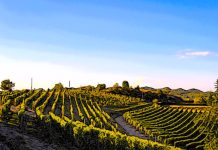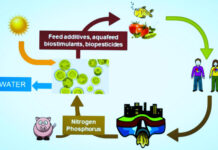‘Useful microorganisms in agriculture‘. The presentation of Vincenzo Michele Sellitto’s book-at the webinar organized on 6/19/20 by Edagricole-was worthwhile to take stock of two real protagonists of sustainable innovation in the agrifood supply chain, microorganisms and microalgae. (1)
Biodiversity, soil, microalgae
Biodiversity-the subject of a special European strategy presented by the Communication on 20.5.20-also deserves specific attention with regard to soils, which express and preserve its heritage.
Soil contains about a quarter of the planet’s biodiversity, which researchers estimate they know less than 1 percent of. It hosts various species of microorganisms. Bacteria, fungi, actinomycetes but also microalgae, which are found in the first millimeters of depth as they draw sunlight.
Microalgae differ from macroalgae in three respects. They are in fact:
– Microscopic, ranging in size from one to a couple of hundred microns, (μm),
– Unicellular organisms, that is, without roots, stems and leaves,
– ubiquitous. They are found in reservoirs (freshwater and saltwater) as in soils, precisely.
Microalgae, possible applications
A unique feature of microalgae is their extraordinary adaptability to a wide variety of environmental conditions. Due to the ability of most of them-as myxotrophic organisms-to process both solar energy and carbon dioxide (through photosynthesis, due to chlorophyll) and that contained in organic substances (through heterotrophism).
Interest in these microorganisms has increased dramatically in the past two decades. In fact, their use has been experimented-with varying success and increasing prospects-in agriculture, aquaculture and animal husbandry, food and nutraceuticals, cosmetics and pharmaceuticals, biopolymers (for bioplastics), and bioenergy. As well as in water and soil treatment and purification.
Microalgae, cultivation (or breeding)
The microalgae cell is composed mainly of proteins, lipids (or fats) and carbohydrates. Species choice and cultivation methods, growth conditions in particular, enable the most suitable organisms to be obtained in relation to different uses.
The most popular breeding systems are based on closed-loop tanks(raceway ponds) or photobioreactors. These make it possible to optimize the exposure of microorganisms to light (natural or artificial, in indoor plants), better control growth conditions, and improve production yields.
Bio-decontamination
Bio-decontamination of water and wastewater, as well as soils, is one of several high-potential uses for microalgae. Both for the removal of nutrients, such as nitrogen and phosphorus, which more than others lead to water eutrophication. Both to purify water from highly toxic environmental contaminants (e.g., heavy metals). Both to rid them of organic compounds and agrotoxic residues.
Chlorella vulgaris and scenedesmus quadricauda were successfully used to break down organic compounds (-90%) and some ‘pesticide’ residues, in 4 weeks. Downstream of a hydroponic tomato crop, whose wastewater was purified to the point of almost zero risk of eutrophication (a major pollutant phenomenon in inland waters). (2)
Microalgae and agriculture, some experiments
The biostimulatory effects of two microalgae species(chlorella and scenedesmus quadricauda) have been tested, in Italy, on beet, lettuce and tomato. By using both extracts, in methanol, and live microalgal cells. Application of the extracts to beet seeds favorably affected germination speed and yield. (3) Their addition to nutrition in hydroponic culture improved root system and gene expression. (4)
Lettuces and tomatoes in turn grew much more, after 3 and after 6 weeks, respectively (5,6). And the biostimulatory action of the extracts has also been shown to influence plant biochemistry. With beneficial effects on two key enzymes in their metabolism, as well as on the switching enzyme between plant primary and secondary metabolism (PAL).
The addition of homeopathic amounts of chlorella and scenedesmus quadricauda (1 mg/kg) to soils in a small experimental crop in turn resulted in a significant increase in tomato growth. In this case, the microalgal biomass stimulated the enzymatic action of the soil, thus increasing its biochemical potential. (7)
Horizons of research and sustainable development
The crucial role of microalgae for human nutrition thus finds further expression in the potential improvement of soils, increased yields in agriculture, perhaps even plant resilience. These horizons are in addition to the concrete prospect of making sustainable plant proteins with high biological value.
The European research project ProFuture – in which our team is participating, as lead partner in Italy – aspires precisely to develop production systems with a favorable ecological balance and costs as low as possible. So as to contribute, with these superfoods, to the
food security
.
Among other things, the research mentioned above highlights how microalgae in agriculture can fully complement systemic circular economy goals. Microorganisms can thus be used to decontaminate wastewater, producing biomass to be transformed into energy, through biodigesters, or into natural fertilizers (depending on purity requirements). What else to wait for?
Dario Dongo and Giulia Torre
Notes
(1) Edagricole, webinar 19.6.20. Michele Selitto, msbiotech spa(Use of microorganisms in agriculture), spoke. Raffaella Pergamo, CREA-PB(Green Deal and Agriculture). Andrea Baglieri, University of Catania(Microalgae and agriculture). Davide Bulgarelli, University of Dundee, Scotland(The microbiome of the rhizosphere), Stefano Mocali. CREA(Importance of soil microbial biodiversity for production sustainability). Massimo Zaccardelli, CREA(Use of antagonistic bacteria and plant growth promoters in horticulture)
(2) Baglieri et al. (2016). Cultivating Chlorella vulgaris and Scenedesmus quadricauda microalgae to degrade inorganic compounds and pesticides in water. Environmental Science and Pollution Research 23(18), doi: 10.1007/s11356-016-6996-3
(3) Puglisi et al. (2020) Effect of Microalgal Extracts from Chlorella vulgaris and Scenedesmus quadricauda on Germination of Beta vulgaris seeds. Plants 9(6):675. doi: 10.3390/plants9060675
(4) Barone et al. (2017). Root morphological and molecular responses induced by microalgae extracts in sugar beet (Beta vulgaris L.). Journal of Applied Phycology. doi: 10.1007/s10811-017-1283-3
(5) Puglisi et al. (2020). Biostimulant Effect and Biochemical response in Lettuce Seedlings Treated with A. Scenedesmus quadricauda Extract. Plants 9(1):123. doi:10.3390/plants9010123
(6) Barone et al. (2019). Novel bioprocess for the cultivation of microalgae in hydroponic growing system of tomato plants. Journal of Applied Phycology. doi:10.1007/s10811-018-1518-y
(7) Barone et al (2019). Effect of living cells of microalgae or their extracts on soil enzyme activities. Archives of Agronomy and Soil Science, 65:5, 712-726, doi: 10.1080/03650340.2018.1521513









